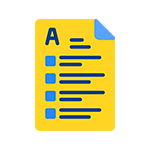Technology brings revolutionary changes to our day-to-day lives. Advancement in information technology shrinks the distance among people. Witnessing variations in cultures and nationalities, we are eager to meet people and foster a channel of communication.
Here, we need to understand the significance of languages and language features: a way to initiate communication and share our thoughts.
“Language, in its widest sense, means the sum total of such signs of our thoughts and feelings as are capable of external perception and as could be produced and repeated at will.” (Henry Sweet).
According to Statista, more than 1 billion people spoke English globally in 2021. Either count English as a native language or second language, the essence of the English language over other languages cannot be ignored. If we talk about the U.S., they don’t have any official language but their legislation and official pronouncements reflect the use of English. Furthermore, the British government also states that their native speakers use English as the primary language.
Related Blog: Complete List of Linking Words
Table of Contents
What Is Language?
Language provides a channel for humans to communicate with each other. With the proper understanding of language, we can share our thoughts with feelings and exchange our beliefs. It teaches us how to laugh, smile, and many more expressions to show our inner sentiments.
Language also allows us to build a society that shares cultural values.
If we use language to communicate with others, then it is called linguistic communication. When you communicate with other mediums (laughing, smiling, and more), you are using non-linguistic communication.
While digging out more information, you should know language features and techniques. It will help you to interpret others’ viewpoints and understand their usage.
Characteristics of Language
- Language is a system as well as a system of symbols.
- Language is learned naturally or structurally.
- Changes in languages are another characteristic that lets people advance their communication.
- Primarily, language is speech-oriented.
“We live in a changing world. We can’t possibly think in terms of the static state of affairs in language or anything else.” Jawaharlal Nehru.
What Are Language Features?
The use of language features offers meaning to communication. They reflect the proper use of sentences, punctuations, words, grammar, phrases, and more. Anything that advances your communication comes under the category of language features.
If we go deep into language features examples, you will get more information to learn. However, learning all language features at once may create a mess in your mind. Therefore, go one by one to make better understanding and retention. Broadly, we divide language features into two categories:
- Descriptive Language: Descriptive language is a vital technique used to provide a detailed description of a place or person for making effective verbal and written communication.
- Persuasive Language: Understanding persuasive language allows the author to use words to evoke thoughts in readers’ minds.
List of English Language Features
1. Level of Formality
While defining the language features based on formality, you can distinguish them into two categories: formal and informal languages
Also Read: Ultimate English Techniques You Must Know!
2. Formal languages
Whether you are writing something or having official verbal communication, you always choose to be formal. Selection of the words, vocabulary, syntax, and structure is the most important aspect of formal language.
Key points:
- Formal language is used for official purposes and radio news. When you write for formal occasions such as weddings, seminars, conferences, or academic works, you use formal language.
- It throws the seriousness of the communication and offers the concept clarity.
3. Informal language
Sharing your thoughts without concentrating on the depth of language technicality comes under informal language.
4. Colloquial language
Colloquial language features share daily conversation, everyday speech, and casual communication. It may be used to create a sense of familiarity. Sometimes, it is also called colloquialism.
For example,
- Kick the bucket
- Head over heels
- How’s things?
5. Slang
Slang is another aspect of informal language expression that belongs to a particular group of people. In a literal sense, slang is a misuse of words and phrases.
For example,
- Bring two bottles of booze for tomorrow’s party.
- Hey Bro, what’s up?
6. Jargon
Jargon reflects technical words that are only used by specific professionals. Other people find it difficult to understand the jargon. It enhances direct clarity and bonding of the same group or profession.
For example,
- Bandwidth
- Shorthand
- Cache
7. Imagination
Being a writer, your choice of words creates imagination in the readers’ mind that is also a part of language features. The use of an imaginary sense in writing makes the description more interesting and amusing.
It is further divided into 3 subsections:
- Metaphor
- Simile
- Personification
8. Metaphor
Metaphor presents a robust comparison between dissimilar things. It is a part of figurative language referring to words or expressions and creates a literal indifference. In order words, it describes an action or an object that is not literally correct but reflects a comparison.
For example,
- You are my heartbeat.
- My mother is a firework.
- John is a couch potato.
9. Simile
While making a description more emphatic or vivid, similes are used to compare, unlike things. It is also a vital aspect of figurative language. Similes differ from metaphors as they highlight alikeness between two things with the use of comparison words.
For example,
- You are sweet as honey.
- I will work for you as long as you work on the LAND project.
- She is as strong as steel.
10. Effects of Sounds
Are you wondering about sounds as part of language features? Sound effects make your writing more memorable. The use of appropriate words makes your writing more eye-catching. It has five components:
- Rhyme
- Alliteration
- Assonance
- Rhythm
- Onomatopoeia
11. Rhyme
A rhyme is a repetition of similar sounds. It also classifies the degree of similarity between sounds in the words. Or, you can say it is the repetition of a sound at the end of words. Rhyme is mostly visible in different forms of poetry. Furthermore, it adds feelings and emotions to your writing.
12. Alliteration
Alliteration demonstrates the repetition of consonants at the beginning of the words in order to link the words together. In simple words, alliteration shares the repetition of sounds or letters in a sentence. Moreover, you will find the sound at the starting of advanced words or closely connected words.
For example,
- Humble House
- Picture perfect
- Quick question
13. Assonance
Assonance is the repetition of vowel sounds in closely related words. It is part of speech in which vowel sounds are repeated in a sentence or phrases.
For example,
- He stood on the road and cried.
- Toss the glass, boss.
14. Rhythm
Rhythm is a repeated pattern of sounds to make the writing more interesting. It acts as the heartbeat of a sentence that incorporates a particular feeling into it. Rhythm boosts our remembrance of a text.
15. Onomatopoeia
Onomatopoeia reflects the sound of a word that is the same as its meaning. Following the process of onomatopoeia, you can create a word that phonetically imitates the sound it describes.
16. Involvement of Audience
Another important aspect of language features and techniques is to show the involvement of persons in your communication. It can be described in the following categories:
- Personal pronouns
- Emotive language
- Rhetorical question
- Imperative sentence
- Cliché
17. Personal pronouns
Personal pronouns are the part of speech referring to a person in communication. If you choose to include personal pronouns in your writing, readers may feel included. It enhances the effectiveness of verbal as well as written communication. Personal pronouns such as I, me, my, he, him, she, her, we, us, and ours.
18. Emotive language
Emotive language is another vital feature of language that evokes emotions in readers or listeners. It will help writers to connect with readers by eliciting an emotional response. Generally, emotive language is part of persuasive writing and helps in manipulating ideas.
Some words in emotive language stimulate positive emotions like lovely, gorgeous, excellent, and intelligent whereas some words produce negative reactions like ugly, duffer, fool, and more.
19. Rhetorical question
A rhetorical question is a question that does not need an answer literally. It is asked in speech or written communication to create a dramatic exposure. Here, writers or speakers do not accept a direct answer rather share their point of view.
For example,
- Who doesn’t love chocolates?
- Wow, who knew?
- Don’t you think it’s the right time to get married?
20. Imperative sentence
An imperative sentence is used to give requests, commands, or suggestions. Simply, you tell your audience to do something. Writing imperative sentences creates a sense of compulsion and may reveal authority.
- Remember to pick up the stitched clothes.
- Don’t sit there.
21. Cliché
Cliché is an expression that loses its effectiveness as it has been overused. It may be interesting to use Cliché in your writing but it creates boring reactions.
For example,
- She is as dumb as a doorknob.
- Live and let live.
- Good as gold.
22. Emphasizing ideas
When you have to snatch the reader’s or listener’s attention to particular arguments, a different type of language feature is used. You need to emphasize ideas to uncover the vital aspects of communication.. Here, are the essential features of language :
- Hyperbole
- Repetition
- Listing
- Parallel structure
- Anecdote
- Quotations
- Statistics
- Slogan
- Degree of adjective or adverbs
23. Hyperbole
Hyperbole is a part of figurative speech that is used to exaggerate statements. Using hyperbole in writing, you can easily emphasize a point.
For example,
- I’m so tired; I could sleep a million years.
- Cry me a river.
24. Repetition
As the name suggests, repetition is the art of saying something again. In simple words, when you choose to repeat words, lines, verses, or phrases in a text, you are creating repetition in your writing. It also helps you to create a beautiful rhythm.
For example,
- Men will be men.
- It’s okay not to be okay.
25. Listing
While demonstrating the language features to emphasize ideas, the listing acts as another crucial element. Through listing, you will add weight to your sayings. It helps in emphasizing a point to let readers understand it deeply.
26. Parallel structure
Parallelism or parallel structure uses the same pattern of words to show their alikeness. It reflects the use of repeating words of similar structure within several sentences.
27. Anecdote
Anecdote is a short interesting tale of a person’s life. It helps speakers to connect with the audience and make their communication interesting.
28. Quotations
Quotations are the thoughts and ideas of popular personalities that are used to justify a point. Quotes are the best aspect of written and verbal communication.
“Talent is cheaper than table salt. What separates the talented individual from the successful one is a lot of hard work.” ~ Steven King
29. Statistics
Statistics represent the numerical information or percentage to support an argument.
30. Slogan
A catchy phrase that reflects a message is called a slogan. It is generally associated with a company or product to highlight its brand value.
Degree of adjective or adverbs
Comparative or superlative: It reflects the degrees of some quality of the adjective and adverbs.
Other Language Features
1. Irony
The irony is a rhetorical device that creates a sense of sincerity. It usually offers humor and sarcasm.
2. Euphemism
When you are not in the mood to say something embarrassing, take the help of a euphemism. Sometimes, people usually avoid saying some unpleasant news related to sex or family planning. Therefore, it is good to use a euphemism.
3. Pun
Pun or paronomasia is a form of word or phrase that reflects the different meanings of a term in order to create a humorous or rhetorical effect.
4. Sensory language
Sensory language uncovers the use of words that link readers to the five senses (touch, sound, smell, taste, and sight)
For example,
Meowing, dazzling, vibrating, and staggering.
Structural Techniques of English Language
Once you check the various language features with examples, you should move to the structural techniques. It will boost your learning and help you to enhance your writing. Some of the following structural techniques are mentioned below:
- Simple sentence
- Complex sentence
- Compound sentence
- Fragment or impact sentence
- Juxtaposition
- Repetition
- Listing
- Anaphora
- Links between paragraphs
- Shifts in focus
- Triple
- Zooming in and out
- Flashback
- Chronological order
- Exposition
- Narrative voice
- Direct speech
- Foreshadow
- Tense
- Climax
Still, Need More Clarification On Language Features? Connect With Experts!
We put the utmost effort to gather crisp information on language feature definition and techniques. After going through this entire article, you will have enough insights into what language features. 25+ language features and techniques are discussed in the write-up to enhance your level of understanding. If you need further knowledge on English language features, don’t hesitate to connect with our experts.
Accessing our online assignment helps to make an unbreakable connection with English writers and share your concerns. You will get proper guidance to resolve your worries related to language analysis examples. We share round-the-clock virtual assistance to address students’ concerns and offer them customized solutions. We understand the technicalities and complications of writing, especially academic writing.
Projecting profound knowledge in the assignment in the most appropriate manner can change the complete outlook of your academic work. If you are juggling with irritating thoughts on writing your assignment, divert your attention to ask for solutions.
Our Related Blogs:
 Santa Clara, CA 95050
Santa Clara, CA 95050 





